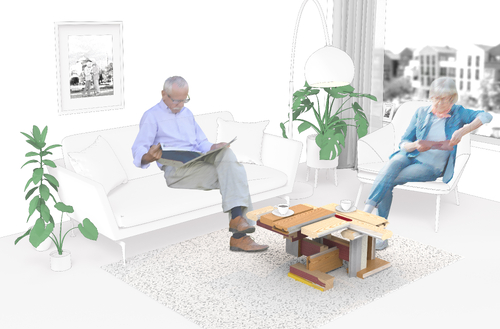Case Study #1: ‘Once my door, now my coffeetable’
Onderdeel van
Trefwoorden
Imagine a small renovation project, like a row of ten houses. Windows and doors are being replaced, and inhabitants are affected by the works. What if tenants were given back a valuable object, made from these doors? A small piece of furniture can help explain the need for a circular economy, given the current ongoing loss of valuable material resources. For tenants, this object can both raise awareness on societal challenges, and create a sense of belonging to their building -which can even be enhanced by involving them in the design. This is the focus of this Case-study: the development of a tool to co-design and produce custom objects from one door, using the potential of wood processing with industrial robots.

Unique designs
Harvested wood from renovations comes in a variety of sizes, type of wood, quality and finishing. The reuse of this uneven material stream can be facilitated by 3D scanning and sorting it upfront. Computer algorithms can then work with the collected data to generate unique designs, made from these pieces. To get a relevant outcome -and not only random packs of connected elements- the designer and/or end-user must define specific rules for these algorithms. These rules could direct the algorithm to create structures with three legs, or connect wood pieces in a strict perpendicular fashion, or place the thickest ones at the bottom, etc. Finally, the designer can re-run the program to optimize a design through various iterations.
---
This case study is part of the 'Circular Wood for the Neighborhood' project, done at the ROBOT LAB and lead by the Digital Production Research Group (DPRG) of the Knowledge Center Technology, Amsterdam University of Applied Sciences (AUAS).
Afbeelding credits
Icon afbeelding: CS1_composition_WEB.jpg